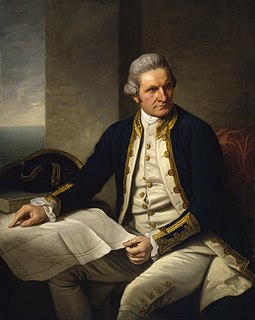Grindle Rock ( 59°01′06.2″S26°39′27.5″W / 59.018389°S 26.657639°W Coordinates: 59°01′06.2″S26°39′27.5″W / 59.018389°S 26.657639°W ) is a conspicuous rock, 213 metres (700 ft) high, lying 0.7 nautical miles (1.3 km) west of Bristol Island in the South Sandwich Islands. It was discovered by a British expedition under James Cook in 1775. It was recharted in 1930 by Discovery Investigations personnel on the Discovery II and named by them for Sir Gilbert E.A. Grindle, Permanent Under-Secretary of State for the British Colonies. [1]

A geographic coordinate system is a coordinate system that enables every location on Earth to be specified by a set of numbers, letters or symbols. The coordinates are often chosen such that one of the numbers represents a vertical position and two or three of the numbers represent a horizontal position; alternatively, a geographic position may be expressed in a combined three-dimensional Cartesian vector. A common choice of coordinates is latitude, longitude and elevation. To specify a location on a plane requires a map projection.

Bristol Island is an 8 km (5-mile) long island lying midway between Montagu Island and Thule Island in the South Sandwich Islands.

Captain James Cook was a British explorer, navigator, cartographer, and captain in the Royal Navy. He made detailed maps of Newfoundland prior to making three voyages to the Pacific Ocean, during which he achieved the first recorded European contact with the eastern coastline of Australia and the Hawaiian Islands, and the first recorded circumnavigation of New Zealand.
Grindle Rock is the easternmost of a chain of rocks extending WSW from Turmoil Point, the westernmost point of Bristol Island. These are Grindle Rock, Wilson Rock and Freezland Rock.
Turmoil Point is the western point of Bristol Island, South Sandwich Islands. This imposing point, rising to 400 m and culminating in a snow-covered summit, is a distinctive landmark when viewed from the west. Named by United Kingdom Antarctic Place-Names Committee (UK-APC). The name refers to the violent air streams commonly encountered during flying operations from HMS seas typical of the locality.
Wilson Rock is a rock, 183 m high, lying 1.4 nautical miles (2.6 km) west of Bristol Island in the South Sandwich Islands. Discovered by Captain James Cook in 1775, but more accurately charted by Admiral Thaddeus Bellingshausen in 1819-20. Recharted in 1930 by DI personnel on the Discovery II and named for Sir Samuel H. Wilson, Permanent Under-Secretary of State for the British Colonies.
Freezland Rock is a conspicuous sharp-pointed rock, 305 metres (1,000 ft) high, located 2 nautical miles (4 km) west of Bristol Island in the South Sandwich Islands. This feature was originally named "Freezland Peak"" by Captain Cook, after Samuel Freezland, the seaman who first sighted it and so discovered the South Sandwich group in 1775. Cook's chart, showing the feature as an insular rock, was verified in 1930 by Discovery Investigations personnel on the Discovery II and the terminology has been altered accordingly.




